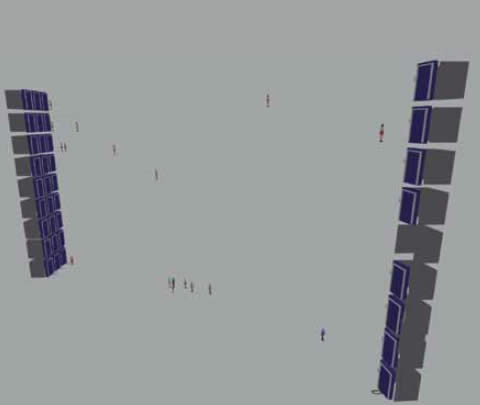
Ben Dubiel
Elevators are part of many people’s daily lives – apartments where we live, offices where we work, and hotels where we travel. However, CDC guidelines for elevator operation during and after the pandemic are causing new concern among landlords on what elevator capacity might look like with social distancing.
Social distancing has turned the service world upside down as the industry went from maximizing the number of guests within a space to needing to maximize space between guests. As mentioned in Marketplace, some building operators are putting in social distancing measures, but how many know the implications downstream? In locations that depend on elevators for vertical transportation, decreased elevator capacity will quickly become a bottleneck that could cause dangerous crowding if not accounted for. In our experience, we’ve found that agent-based simulation is the best option for understanding and mitigating elevator operation with social distancing.
Risks Involved in Reopening a High-Rise
As with all situations that involve potential crowds, there are added risks with reopening during and after the pandemic. Not addressing these risks could lead to tenant dissatisfaction and a potential spike in vacancies as companies begin to adopt a work-from-home culture or residents flee from high-rise housing.
The most common risk we’ve observed is tenants congregating in lobbies due to reduced elevator capacity. Individuals will usually adhere to social distancing guidelines if they are given markers on where to stand. If these markers are not provided, the group will begin to crowd around the door to ensure they make it into the establishment as soon as possible.
Assuming an intuitive, clearly marked queue is planned, this can then lead to a secondary risk: limited space within lobbies. We’ve found that socially distancing a queue can require three to six times more space and landlords will find the limited space they have disappears quick during periods of high demand.
The final risks are a product of the long waits that could develop if demand is not properly planned for: lower productivity and frustration. Waiting 5-20 minutes each time a tenant calls an elevator will add up quickly. The resulting dissatisfaction will result in higher vacancies as people are forced to make a change.
Capacity Depends on Many Compounding Variables
Elevator throughput is a complex equation that depends on many variables within the infrastructure and operation. Only some of these variables are controllable by the building operator.
– Elevator operating methods (e.g. door close delay and operational methodology) are usually variable and can be controlled systematically. Understanding the proper settings in your environment can be difficult if the rest of the equation is unknown.
– The building and lobby layout are typically limited by the physical infrastructure and need to be worked around to determine the most efficient operation.
– Volume of demand will depend on the size and operation of the building. This can be controlled by working with tenants to reduce access to the building to only necessary activity.
– Arrival rate varies widely by the operation of each tenant in the building. Each operation or tenant will have a unique arrival rate. Combining all arrival rates along with the associated volume of demand will add up to a larger arrival curve that will ultimately determine the periods of peak demand.
– The destination of tenants complicates the equation immensely. If tenants arriving at similar times have significant variations in destination floor, the elevator travel time will grow and thus the resulting elevator capacity will shrink.
Using Simulation to Model Operation Scenarios
Because each operation is unique and the solution can be difficult to determine, we recommend agent-based simulation to find the optimal solution through experimentation. Using simulation, we can model the base scenario to determine the extent of the concern given the expected demand upon reopening. In the movie below, an example of a base scenario for a nine-story office building is shown:
After the base analysis is complete, the model can then be modified with the help of building operators to evaluate different mitigation techniques and remove the uncertainty from the reopening plan.
A few mitigation techniques that are being used in the industry include:
– Technology: Elevator timing and logic can be adjusted to operate more effectively with smaller groups riding.
– Manual demand management: Hosts can be used to manually sort riders to make the trips as efficient as possible resulting in increased elevator throughput.
– Demand mitigation: Solutions like dedicated floor service, assigning days and times for elevator use, and incentivizing stair use can increase capacity in certain scenarios.
These scenarios can be modeled before reopening to evaluate their effectiveness safely in a risk-free environment.
Results Provide Details on the Safest Operational Plan
Metrics are used to evaluate each scenario during modeling and experimentation. Elevator capacity, queue size, wait times, and required operators are a few of the metrics we use to ensure we identify the optimal scenario. The final step in the process would be to justify any recommended changes, infrastructure or otherwise, with the potential avoidance of revenue loss that would come from a decrease in move-outs or safety hazards.
The movie below shows an analysis of a museum operation that depends on elevators for vertical transportation. This analysis helped the operators understand the resulting elevator capacity, which was reduced significantly (up to 70%). This information provided the needed insight for the number of tickets they could sell for a specific time period to provide a safe and fun environment for their guests.
———-
Credit: integratedinsight.com




